Brazil’s most beautiful library goes viral
The Royal Portuguese Cabinet of Reading, a little-known cultural gem founded 185 years ago in Rio de Janeiro, is seeing throngs of new visitors thanks to TikTok and Instagram
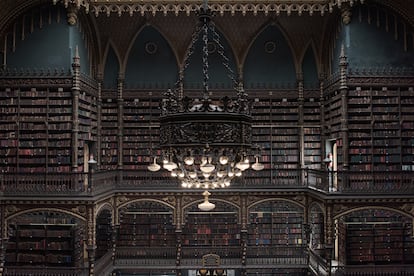

Mondays are the most popular time to visit the Real Gabinete Português de Leitura, or Royal Portuguese Cabinet of Reading, Brazil’s great sanctuary of Portuguese books and culture, and one of the most beautiful libraries in the world, located in the heart of the sprawling coastal city of Rio de Janeiro. On Saturday, June 25, when most of Rio’s other museums and cultural institutes were closed for the weekend, the Royal Cabinet saw an endless stream of visitors. Natural light filtering down through the skylight, dimly illuminating the reading room, with its towering walls of multicolored book spines — nearly 400,000 antique, leather-bound volumes in total. For decades, academics have treasured this spectacular library — the largest collection of Portuguese authors outside Portugal — as a place of quiet study. But in recent years, it has become an increasingly popular backdrop for photos and selfies, with crowds of visitors swarming the stately main hall to gaze up at the walls of books and pose for social media posts.
The Royal Cabinet was one of Rio’s little-known cultural gems, until it went viral on Instagram and TikTok. As the institution’s long-time coordinator, Orlando Inácio, explains: “It’s an effect of social media. They come, take pictures, and make posts, then others see it and want to come too.” The library’s popularity first started to rise around the time that the 2014 World Cup and 2016 Olympic Games came to Rio, when Time magazine called the Cabinet the fourth most beautiful library in the world. Its fame has only grown since.
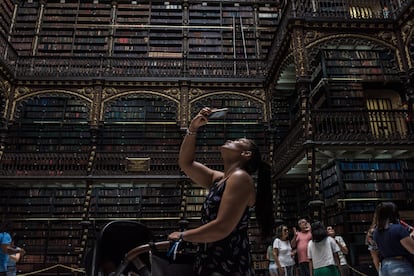
The new crowds of visitors coexist, often awkwardly, with the library’s traditional denizens: scholars of Portuguese history, literature, and culture. A handful of researchers, seated at small tables, struggle to concentrate on their reading amid the thrum and bustle of tourists and locals immortalizing the moment with their smartphones. Anyone can borrow books, says librarian Sylvia Franca, but few lay readers visit the library for the content of its collection.
The history of the Royal Cabinet is similar to that of the country’s other lusophone cultural institutions. It was founded 185 years ago by a group of roughly 40 Portuguese immigrants, only 15 years after Brazil gained its independence. “They created the library in 1837 to improve the cultural education of the Portuguese community in Rio, since most of those who came had no formal education,” explains Francisco Gomes da Costa, the library’s Portuguese-born president. “They would arrive alone, and then send for their wives and children. They also established literary lyceums to instruct immigrants in reading and writing, and founded relief houses to provide social assistance to the Portuguese immigrant community,” says Da Costa, who himself crossed the Atlantic, alone, when he was only 17 years old, following in the footsteps of his uncle.
Teenagers in beach dresses and flip-flops, middle-aged couples in shorts, and families with baby strollers scramble to find vacant spots to strike a pose in front of the towering shelves of books, which span the breadth of Portuguese literature and include codices and manuscripts from the past several centuries.
Among the thousands of volumes are the library’s prized gems: a first edition of Os Lusíadas, Luis de Camões’s 1572 epic, purchased from the Jesuits; Ordenãçoes de Dom Manuel, published in 1521; and the original manuscript of Amor de Perdição, written by Camilo Castelo Branco in 1861.
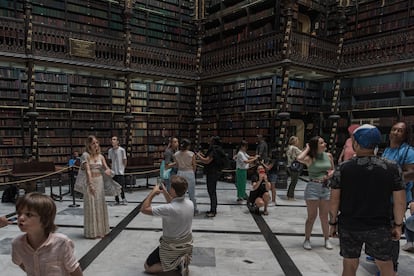
For the vast majority, this is their first visit (and probably their last). Such is the case for 40-year-old French tourist Florent T. “I saw the photos on Instagram, and they were lovely,” Florent says. “But it’s even more beautiful in real life.” Foreigner tourists mingle with Brazilian vacationers, along with visitors from Rio itself, many having travelled from the city’s faraway outskirts. After learning about the library from a TikTok video, Lucas, an 18-year-old student, and his friends Kaylane and Maria Clara, took a train and an Uber all the way from Bangú, a neighborhood in Rio’s West Zone.
Professor Marceli Braga, 41 and also from Rio, was familiar with the institution, but had never had seen the inside its majestic main room until now. “We never came before because it isn’t usually open on weekends,” she says. Journalist Bruno Barreto, 36, brought his mother, along with the rest of their family, to show them the setting for his new novel, titled A chave (The Key), which he describes as “a journey through time.”
To a certain extent, the library’s newfound fame has meant that many Cariocas — as Rio’s locals are known — who had never seen the inside of the Royal Cabinet, or were not even aware they could visit such a cultural and architectural treasure free of charge, are now discovering its wonders for the first time. The library has stood in its current location since the building was first inaugurated in 1887 by Princess Isabel, in the waning years of the Brazilian Empire. “Even back then, it housed some 50,000 books,” says Da Costa.
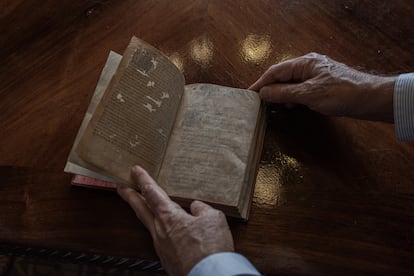
At first sight, many mistake the Royal Cabinet, with its imposing facade modeled after the Jerónimos Monastery in Lisbon, Portugal, for a church, and they make the sign of the cross before entering.
From the beginning, the library was designed to last: it was built to withstand Rio’s hot and humid climate, as well as the potential for fire. This is in large part what gives the main reading room its unique personality — its ornate, Neo-Manueline style and atrium-like appearance. The building’s framework and walls are made entirely of iron, and the shelving is built from jacaranda, a dense hardwood. The tragic 2018 fire that consumed the National Museum of Brazil — the country’s oldest scientific institution, also located in Rio — is enough to give any cultural manager nightmares. That museum also received few visitors — fewer, at least, than the outpouring of grief in the aftermath of its destruction might lead one to believe. In its final year of operation before the fire, the National Museum had less visitors than the number of Brazilians who passed through the Louvre, in Paris.
Thanks to the many donations received and purchases made over the past nearly two centuries, the Royal Portuguese Cabinet of Reading now houses between 350,000 and 400,000 volumes. “We have to be pretty selective with our acquisitions,” says Da Costa. The library includes works documenting the legacy of Marcelo Caetano, the prime minister of Portugal overthrown by the Carnation Revolution in 1974, who fled to Brazil, then under a dictatorship.
Portugal itself boasts one of the world’s most beautiful historic bookstores: Livraria Lello, in the city of Porto. But as a colonial power, the country worked to keep its subjects in a state of complete ignorance for centuries. From the arrival of Pedro Alvares de Cabral to northeast South America in 1500, until the Portuguese royal family left Brazil in 1808, fleeing Napoleon’s troops, books and printing were forbidden. They had to be smuggled into the colony. In fact, the colonial regime’s aversion to education meant that it wasn’t until the late 20th century that Brazil would open its first university.
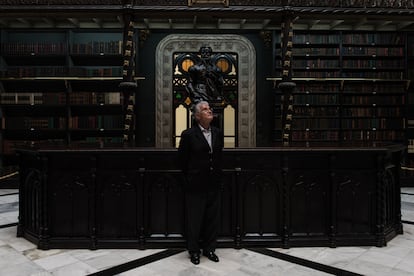
The Royal Cabinet is also unique in that it has served as one of Portugal’s “legal deposits,” or national book repositories, for over a century — a privilege that, until recently, was shared with the former colony of Macao. Every year a shipment arrives with a copy of every book published in Brazil’s former metropole. “They send us about 10 tons of books a year, by boat,” says Da Costa. Portuguese translations of works by the likes of Thomas Piketty and Henry Kissinger sit on modern shelves housed in annexes that adjoin the library’s main building.
The Royal Cabinet of Reading does not receive any support from the Portuguese or Brazilian governments. Rather, the institution pays its bills from the profits generated by its real estate holdings. “We don’t have a lot of property, but what we have is quite good,” says Da Costa, who previously served as the executive director of the Brazilian branch Banco de Santander, one of the largest banking institutions in the world. “Downtown is suffering right now, but it will recover soon enough,” he says. Rio’s historic center, home to hundreds of offices and businesses, is bustling on weekdays but almost deserted on Saturdays and Sundays, when the only people around are the city’s homeless. That’s why Brazil’s most beautiful library is typically only open during business hours, from Monday to Friday.
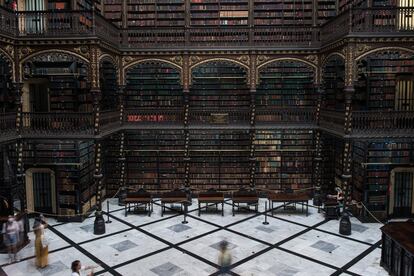
Tu suscripción se está usando en otro dispositivo
¿Quieres añadir otro usuario a tu suscripción?
Si continúas leyendo en este dispositivo, no se podrá leer en el otro.
FlechaTu suscripción se está usando en otro dispositivo y solo puedes acceder a EL PAÍS desde un dispositivo a la vez.
Si quieres compartir tu cuenta, cambia tu suscripción a la modalidad Premium, así podrás añadir otro usuario. Cada uno accederá con su propia cuenta de email, lo que os permitirá personalizar vuestra experiencia en EL PAÍS.
¿Tienes una suscripción de empresa? Accede aquí para contratar más cuentas.
En el caso de no saber quién está usando tu cuenta, te recomendamos cambiar tu contraseña aquí.
Si decides continuar compartiendo tu cuenta, este mensaje se mostrará en tu dispositivo y en el de la otra persona que está usando tu cuenta de forma indefinida, afectando a tu experiencia de lectura. Puedes consultar aquí los términos y condiciones de la suscripción digital.
More information
Últimas noticias
The complicated life of Francesca Albanese: A rising figure in Italy but barred from every bank by Trump’s sanctions
Pinochet’s victims grapple with José Antonio Kast’s rise in Chile
Reinhard Genzel, Nobel laureate in physics: ‘One-minute videos will never give you the truth’
Half of Scotland is in the hands of 420 property owners
Most viewed
- Pablo Escobar’s hippos: A serious environmental problem, 40 years on
- Reinhard Genzel, Nobel laureate in physics: ‘One-minute videos will never give you the truth’
- Why we lost the habit of sleeping in two segments and how that changed our sense of time
- Charles Dubouloz, mountaineering star, retires at 36 with a farewell tour inspired by Walter Bonatti
- The Florida Keys tourist paradise is besieged by immigration agents: ‘We’ve never seen anything like this’










































